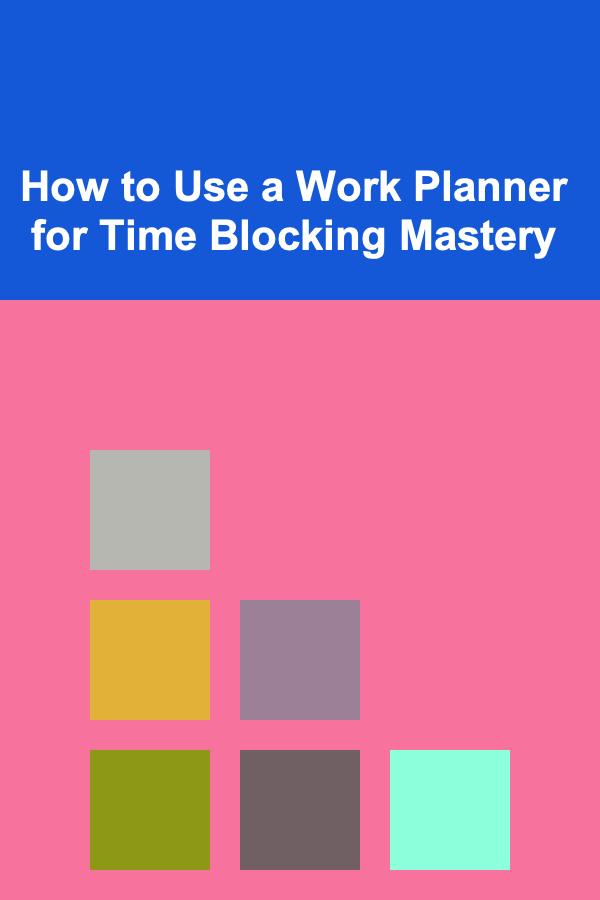
How to Use a Work Planner for Time Blocking Mastery
ebook include PDF & Audio bundle (Micro Guide)
$12.99$9.99
Limited Time Offer! Order within the next:

Time blocking is a powerful productivity technique that has been widely embraced by professionals, entrepreneurs, and high achievers across various industries. It involves dividing your workday into discrete blocks of time, each dedicated to a specific task or set of tasks. The goal is to increase focus, reduce distractions, and make the most of every hour. Using a work planner for time blocking mastery can help you stay organized, manage your tasks effectively, and achieve your goals with ease. This article explores how to use a work planner for mastering time blocking, with practical tips and strategies to implement the technique seamlessly into your daily routine.
What is Time Blocking?
Time blocking is a time management method where you allocate specific blocks of time for particular tasks, activities, or projects. Instead of juggling multiple tasks throughout the day or working on tasks as they come up, time blocking involves intentionally setting aside time for each task in advance. This technique helps to eliminate multitasking, improve focus, and create a structure to your workday.
For example, rather than working sporadically throughout the day and checking your email whenever it arrives, you would designate a specific time, such as 9:00--9:30 AM, to focus solely on reading and replying to emails. During this time block, you do not allow yourself to engage in other activities or be distracted by non-essential tasks.
The benefit of time blocking is that it forces you to prioritize, plan ahead, and create a more deliberate schedule. When executed properly, it leads to higher productivity, reduced stress, and a greater sense of accomplishment.
How to Use a Work Planner for Time Blocking Mastery
A work planner can be an invaluable tool for successfully implementing time blocking into your workday. Whether you use a physical planner, a digital calendar, or a combination of both, having a system in place to track your time blocks is essential. Below is a step-by-step guide to using a work planner for time blocking mastery.
A. Step 1: Choose Your Planner
The first step is to choose a work planner that suits your preferences and needs. You can go for a traditional paper planner, a digital planner (such as Google Calendar), or an app-based planner (like Todoist or Trello). The key is to pick a tool that you feel comfortable with and can easily integrate into your routine.
- Paper Planners: Ideal for those who like to physically write things down. Paper planners also allow for greater creativity and customization. Some planners are specifically designed for time blocking, featuring pre-determined sections for each time block.
- Digital Planners: Perfect for those who prefer the convenience of having their schedule available on multiple devices. Digital planners allow for easy editing, reminders, and color coding to differentiate between tasks.
- Hybrid Approach: Some people use a combination of both digital and paper planners, using digital tools for reminders and tracking while utilizing a physical planner for note-taking and reflecting on their progress.
B. Step 2: Identify Your Priorities
Before you can begin time blocking, it's important to know what your priorities are. A work planner is most effective when you have a clear idea of your goals and what tasks need to be completed. Start by identifying your top priorities for the day, week, and month.
- Daily Priorities: These are the most important tasks you need to accomplish today. Write them down in your planner.
- Weekly Goals: Look at your upcoming week and set clear, actionable goals that align with your long-term objectives.
- Monthly or Long-Term Projects: If you have larger projects or goals, break them down into smaller, manageable tasks that you can work on in time blocks.
By understanding your priorities, you will have a clearer sense of which tasks to allocate time for during the day.
C. Step 3: Divide Your Day into Blocks of Time
The next step is to divide your workday into specific blocks of time. When setting time blocks, it's essential to keep a few key principles in mind:
- Determine Your Ideal Work Hours: Reflect on your most productive hours. For example, if you're a morning person, schedule your most important tasks in the early hours of the day when you're naturally more focused.
- Allow for Breaks: Make sure to include breaks between time blocks. This ensures that you can recharge and refocus.
- Consider Task Duration: Some tasks, like responding to emails, may only take 30 minutes, while others, such as writing a report, may require a couple of hours. Allocate time blocks that fit the scope of each task.
- Keep Time Blocks Realistic: Be mindful not to overload yourself with too many time blocks. Aiming for around 4--6 focused blocks per day is often ideal, depending on the complexity of your tasks.
Once you have these elements in mind, begin scheduling your time blocks in your planner.
Example:
- 8:00--9:00 AM: Morning routine and light admin work (checking emails, reviewing calendar)
- 9:00--11:00 AM: Focused work session -- Writing blog post
- 11:00--11:30 AM: Break (walk, stretch, hydrate)
- 11:30 AM--1:00 PM: Focused work session -- Responding to client emails and calls
- 1:00--2:00 PM: Lunch and personal time
- 2:00--4:00 PM: Focused work session -- Working on a project presentation
- 4:00--4:30 PM: Break
- 4:30--5:30 PM: Administrative tasks (filing, organizing, preparing for tomorrow)
D. Step 4: Prioritize Your Time Blocks
One of the most important aspects of time blocking is ensuring that you're dedicating the right amount of time to the most important tasks. Your work planner will be key to this process. Start by marking your high-priority tasks and allocating the appropriate amount of time to them.
- High-Priority Tasks: These tasks contribute directly to your long-term goals. Set aside large, uninterrupted time blocks for these.
- Low-Priority Tasks: These are tasks that are necessary but not as urgent. Allocate shorter time blocks for them, or if possible, batch them together during times when you're not at your peak focus.
By prioritizing your time blocks, you ensure that you are working on the tasks that matter most and avoiding distractions.
E. Step 5: Monitor and Adjust as Necessary
Using a work planner for time blocking is not a static process; it requires flexibility. Things don't always go according to plan, and sometimes you'll need to adjust your time blocks on the fly. If you find that a certain task is taking longer than anticipated, don't be afraid to adjust your schedule.
- Track Progress: At the end of each day or week, take a moment to reflect on your time blocking efforts. Did you accomplish your goals? Where did you struggle? Understanding these patterns will help you improve your future time blocks.
- Make Adjustments: If certain tasks consistently take longer or shorter than expected, adjust your time blocks to reflect this. Additionally, ensure that you're leaving space for unexpected events or tasks that may arise.
F. Step 6: Incorporate Flexibility and Downtime
While time blocking is about structure, it's also essential to allow room for flexibility. Over-scheduling can lead to burnout, and it's important to be kind to yourself. Ensure that your time blocks allow for downtime and reflection.
- Buffer Time: Include buffer time between tasks for any overruns or interruptions.
- Time for Reflection: At the end of each day, take a few moments to review your progress, reflect on what worked well, and identify areas for improvement.
Benefits of Time Blocking with a Work Planner
When used effectively, time blocking in combination with a work planner offers several benefits:
A. Increased Focus and Productivity
By scheduling your tasks in advance and dedicating specific blocks of time to each, you reduce the temptation to multitask. This leads to improved focus and efficiency.
B. Reduced Stress
Time blocking removes the chaos of trying to juggle multiple tasks at once. With a clear plan in place, you can approach your day with a sense of calm and confidence.
C. Better Work-Life Balance
With time blocking, you're less likely to overwork yourself because you can allocate time for personal activities and breaks. This balance is essential for maintaining long-term productivity.
D. Improved Goal Achievement
When you focus on your priorities and dedicate uninterrupted time blocks to important tasks, you move closer to achieving your long-term goals. The clarity provided by time blocking allows you to stay on track and make measurable progress.
Conclusion
Mastering time blocking with a work planner is a highly effective way to manage your time, stay focused, and boost productivity. By following the steps outlined above, you can create a structure that helps you tackle your tasks with efficiency and purpose. Remember, consistency is key. With regular practice, time blocking will become an invaluable tool that helps you maximize your potential and achieve your personal and professional goals.
Reading More From Our Other Websites
- [Stamp Making Tip 101] The Complete Guide to Choosing the Right Stamp for Your Company's Needs
- [Personal Investment 101] How to Make Money by Developing AI Applications for Businesses
- [Home Holiday Decoration 101] How to Hang Holiday Lights Without Overwhelming Your Space
- [Personal Care Tips 101] How to Protect Your Skin from Environmental Stress with Body Lotion
- [Whitewater Rafting Tip 101] Preparing Young Rafters: Gear, Snacks, and Fun Activities
- [Home Staging 101] How to Transform a Family Home into a Show-Stopping Listing
- [Organization Tip 101] How to Find Your Peak Productivity Hours Each Day
- [Home Family Activity 101] How to Have a Family Nature Walk and Discovery Day
- [Home Party Planning 101] How to Apply Expert Tips for Party Decorating for Small Spaces
- [Organization Tip 101] How to Organize Your Home Office for Better Productivity

How to Research Charities to Ensure They Are Legitimate
Read More
How To Understand the Role of Producers in Modern Music
Read More
How To Create a Positive Money Mindset for FIRE
Read More
10 Tips for Finding Time to Play Board Games
Read More10 Tips for Using a To-Do List Planner for Habit Tracking
Read More
10 Tips for Preserving Your Stamp Collection Long-Term
Read MoreOther Products

How to Research Charities to Ensure They Are Legitimate
Read More
How To Understand the Role of Producers in Modern Music
Read More
How To Create a Positive Money Mindset for FIRE
Read More
10 Tips for Finding Time to Play Board Games
Read More10 Tips for Using a To-Do List Planner for Habit Tracking
Read More